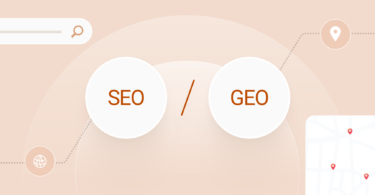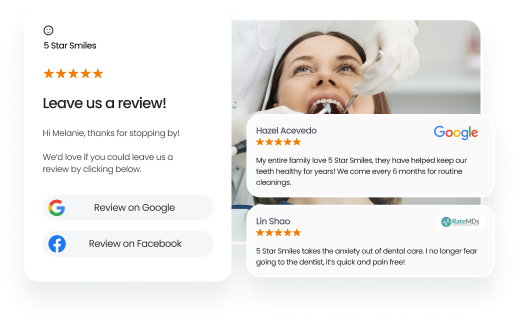There was a time when search used to be about blue links and clicks. Today, it’s about answers, often generated by AI and increasingly shaped by community voices.
I put it to the test with a search for “best HVAC repair near me,” and the most useful result wasn’t a local business’s website. It was a six-year-old Reddit thread where homeowners compared invoices, debated response times, and named the technicians they’d call again.
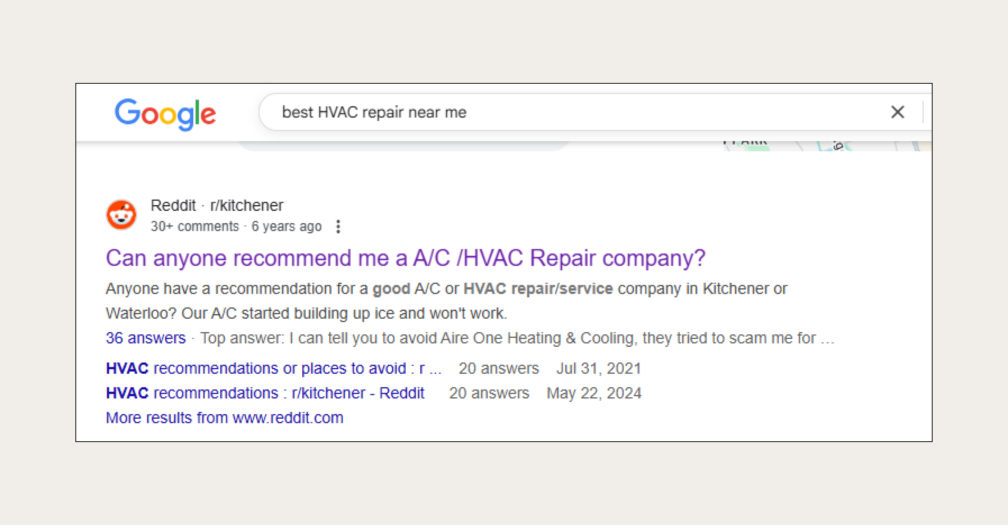
At the very top of the results, Google’s AI Overview had already summarized that thread, compressing a messy, human discussion into a neat paragraph.
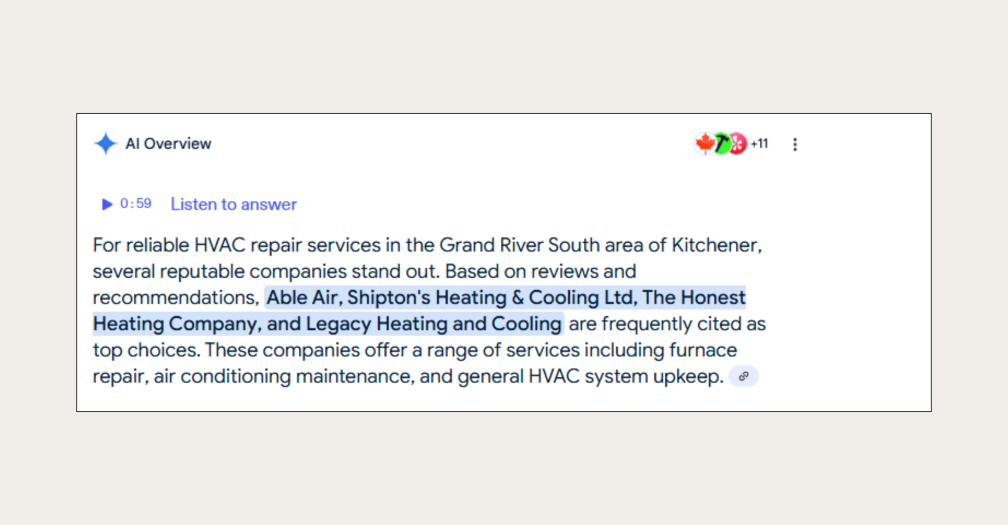
That moment made me pause: if AI is paraphrasing the crowd, what’s left of your carefully built SEO strategy?
Table of contents
- Reddit, forums, and AI overviews now shape your brand’s first impression
- Why AI relies on communities for “truth”
- Why do people trust strangers over brands?
- Even one comment can shape your brand’s reality
- Local services are in the spotlight
- Product review publishers: Spotlight vs. click loss
- Treat the community as an owned asset
- AI is learning from communities. Make sure it’s learning from you
- From rankings to resonance: The new metrics
- Governance and risk
- Be the source, not the summary
Reddit, forums, and AI overviews now shape your brand’s first impression
For years, we optimized landing pages and metadata to win the click. But the front door to your brand has quietly moved. Users now add words like “Reddit,” “forum,” or “reviews” to their searches to bypass polished marketing and go straight to lived experience.
Google has leaned into this behavior. Its “Discussions & Forums” carousels highlight community voices, while AI Overviews often summarize those same conversations, satisfying intent without sending a visitor to your site.
The result is undeniable: discovery now runs through the internet’s comment section. By early 2025, AI Overviews appeared in a significant share of search queries, especially in categories where human context matters most.
That raises a new question for brands. It’s no longer just “Do I rank?” but “Am I part of the answer?” Because being present in that answer layer doesn’t just get you found; it positions your brand as credible at the moment of decision.
Why AI relies on communities for “truth”
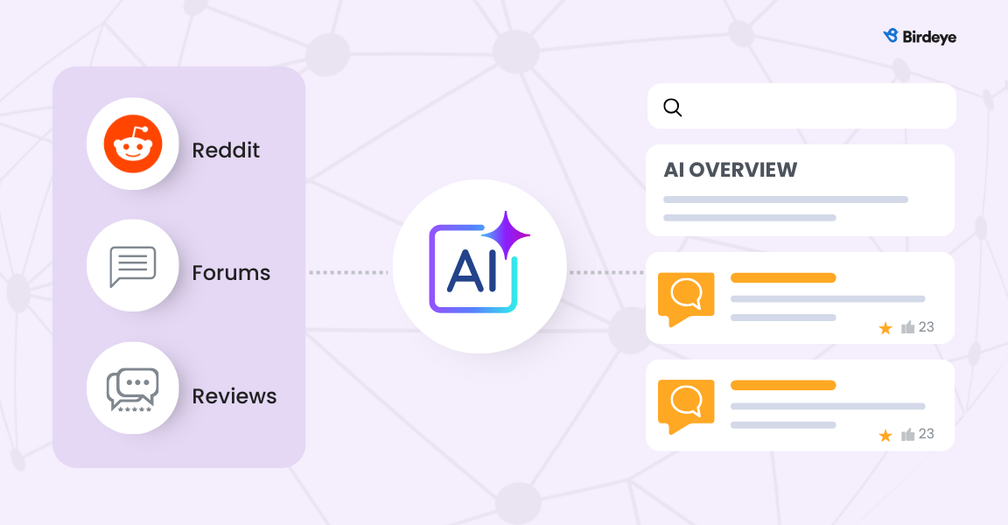
AI models turn to communities because they offer what static web pages often lack: recency, nuance, and disagreement. A product page can tell you the specs, but it won’t mention that last Tuesday’s update broke compatibility with older devices.
On the other hand, communities will do it for you. They surface edge cases, trade-offs, and lived experiences—the messy realities real customers encounter.
That’s why licensing deals with platforms like Reddit and Stack Overflow matter. They feed AI a curated stream of what people are saying.
But the “truth” AI learns here isn’t fact-checked. It’s crowdsourced, biased, or incomplete, and yet it shapes what AI says next. If you’re absent from those conversations, someone else’s version of your story becomes the one AI repeats.
Why do people trust strangers over brands?
When it comes to high-stakes or unfamiliar decisions, social proof now outranks corporate polish. A glossy website or ad can feel distant, whereas an unfiltered review or forum post feels real. People value warmth, human stories, and candid feedback over credentials or claims. They don’t just want an answer. They want to know someone like them has tried it, hated it, or loved it, and why.
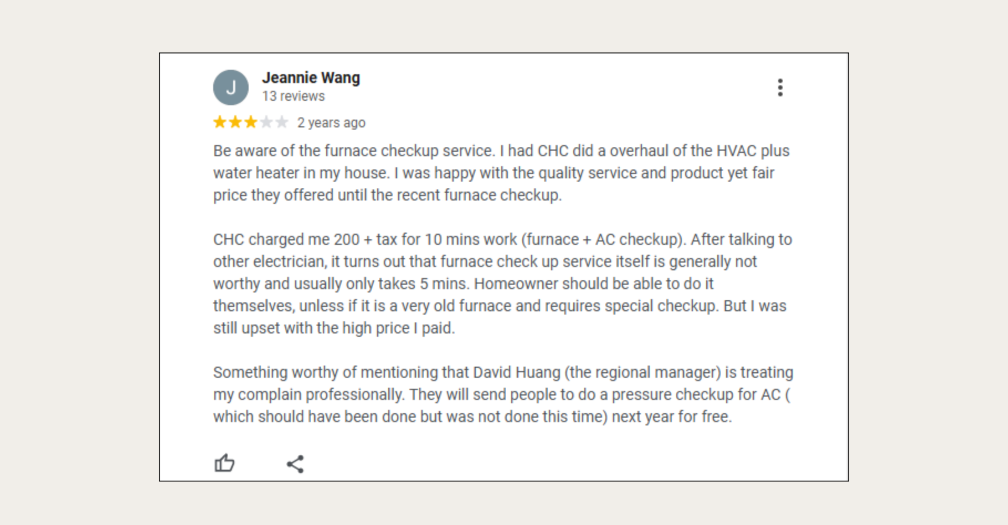
Even one comment can shape your brand’s reality
Today, it doesn’t take much to shape perception. One forum post that says your service is “slow to respond” can quickly snowball. Google highlights it in “Discussions,” an AI Overview repeats it in a “near me” search, prospects bring it up in sales calls, and soon competitors are echoing it and reviewers are piling on. Before long, “slow to respond” isn’t just one person’s opinion; it’s the internet’s version of your brand.
Once AI starts repeating it, that narrative becomes the default until you replace it with something stronger, in public.
Local services are in the spotlight
Local search is where these changes are playing out most visibly. Add a place name—like “plumber in Austin”—and the odds of seeing an AI Overview jump dramatically. Proximity now influences who gets surfaced in the answer layer, sometimes even before the local pack or organic results. The closer your business aligns with a customer’s location and intent, the more likely AI is to cite you.
What to do now:
- Create location-specific service pages that reference neighborhoods, landmarks, and FAQs written in customer language.
- Use reviews as proof points by requesting them consistently, responding authentically, and highlighting outcomes where conversations started.
- Optimize your Google Business Profile (GBP) with accurate services, fresh photos, and descriptions using the words customers search for.
Product review publishers: Spotlight vs. click loss
For publishers specializing in product or service reviews, AI Overviews can be both a validation and a risk. Being cited by Google or another AI platform validates your authority, but it can also mean the query is satisfied right there, with traffic flowing to a retailer instead of your site.
How to compete:
- Make your content extractable and trustworthy by using comparison charts, spec tables, and “best for” recommendations that AI can lift and cite.
- Deliver value AI can’t compress with proprietary testing, long-term performance insights, or interactive tools that survive summarization and drive the click.
The same principle applies to local businesses. Reviews are now part of the answer layer itself. A credible online presence, paired with detailed customer stories, ensures that when AI cites you, it leads to actual customers, not just impressions.
Treat the community as an owned asset
In a community-driven search world, what people say about you directly shapes what AI repeats about you. That’s why you shouldn’t just “manage” communities. You should cultivate them like an owned asset. Here’s how you can achieve it:
- Collect broadly: Gather reviews, user-generated content (UGC), and feedback so proof points are fresh, visible, and easy for AI to find.
- Respond publicly: Address issues where they appear. Document fixes and outcomes in the same thread or review. Visible accountability rewrites the record AI learns from.
- Syndicate consistently: Share proof points across profiles, listings, location pages, FAQs, and the same threads where conversations began.
Birdeye makes this easier by bringing collection, response, and syndication into one platform, helping ensure AI sees the most accurate, up-to-date proof of your brand’s value everywhere customers are looking.
AI is learning from communities. Make sure it’s learning from you
AI models are already scanning forums, reviews, and social conversations to shape the answers they give. If your brand isn’t present in those spaces, the story gets told without you—and AI will repeat someone else’s version.
Operating in the new SERP: A practical playbook
To compete in a search environment shaped by forums and AI Overviews, you need to show up where conversations are happening and make your contributions easy for AI to understand. Here’s how to do it:
1. Map your community graph: Find where your buyers actually talk—subreddits, product communities, Discord channels, YouTube comments, niche forums, local Facebook groups, app store reviews, etc. Prioritize the spaces that consistently appear for your highest-intent searches.
Pro tip: As Andrew Shotland from LocalSEOGuide.com points out, you can also use Google’s Discussions and Forums results to quickly find the forum posts and threads Google finds most helpful. It’s a great way to discover what real people are saying, and what Google (and AI) is likely to highlight.
See examples below showing how these forum results appear in Google search:
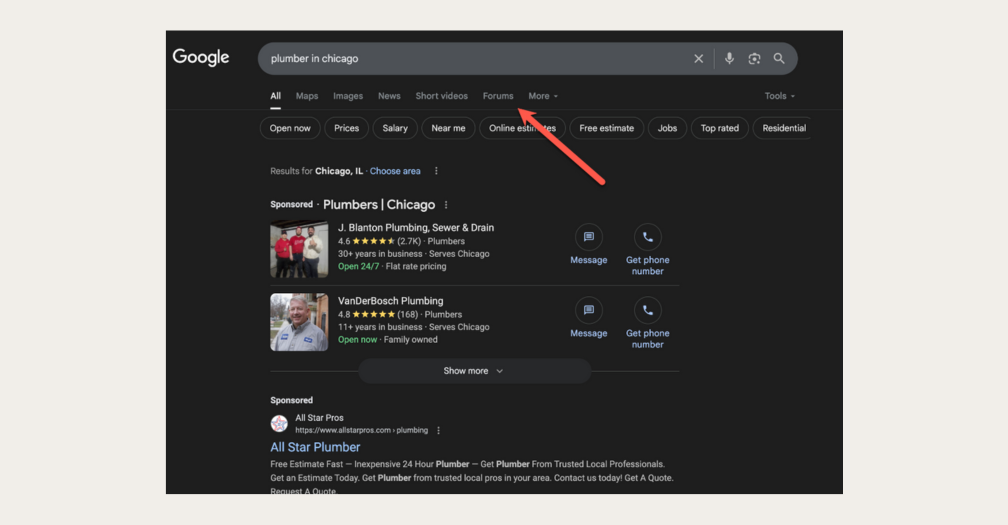
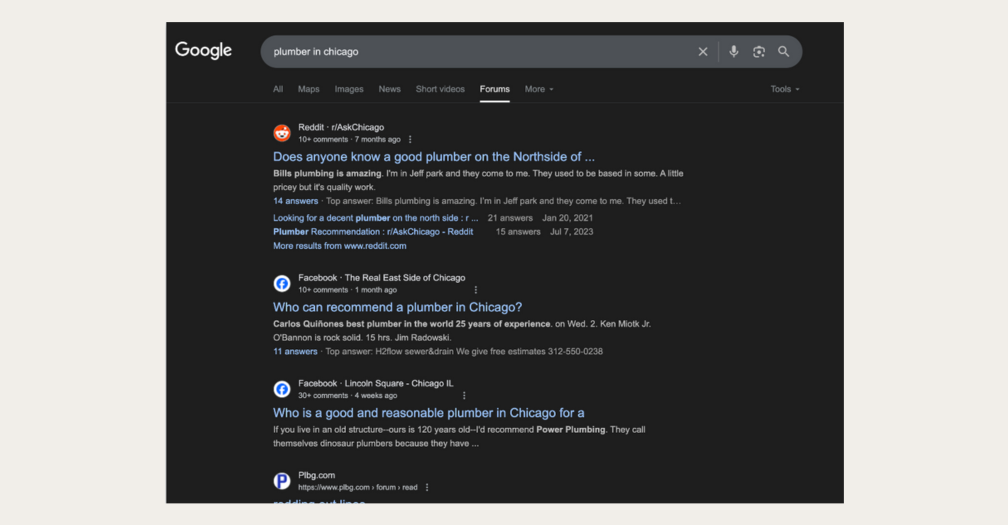
2. Close loops in public: Treat negative reviews or forum posts like open support tickets. Resolve the issue, then post the outcome—refunds, fixes, or policy changes—where the conversation started.
3. Create content people understand and AI can use: Write FAQs and explainers in customer language with specifics like model numbers, timelines, and locations. Use structured data so AI can read and cite it. Encourage reviewers to include details; they improve both human trust and AI retrievability.
4. Turn conversations into curated insights: Summarize what people tried, what worked, and what didn’t, crediting contributors where appropriate. Invite practitioners and superusers to co-author. Real thought leadership comes from curating and translating these conversations, not just adding another opinion.
From rankings to resonance: The new metrics
Traditional metrics like rankings and clicks can’t tell you if you’re showing up in the answer layer. What matters now is influence: whether AI platforms are pulling your brand into the responses people actually see. So, add leading indicators that measure influence.
For local brands:
- AI Overview inclusion rate, segmented by searches with and without place names
- Google Business Profile impressions and actions when AI Overviews appear
- Review velocity, sentiment trends, and response times
For publishers:
- Share of citations in AI Overviews for target queries
- CTR differences between queries with and without AI Overviews
- Affiliate performance by query type; assisted discovery patterns from brand lift
It’s also important to measure the whole journey from mention to conversion: someone talks about you in a forum → AI cites it → the searcher clicks to your profile or location page → they convert.
Example:
A Reddit thread praises your “fast weekend service.” Two weeks later, AI Overviews start citing it for “plumber near me.” Clicks to your GBP rise 18%, bookings increase 12%. That lift traces back to one community mention.
Governance and risk
Operating in an AI-shaped search environment means thinking about brand safety as much as visibility. Three risks stand out:
- Misattribution and hallucination: AI summaries can get details wrong. Monitor them closely, and request corrections quickly. Keep a clear “source of truth” online—written in plain, precise language with exact names, dates, and details—so models pull the right information.
- Platform concentration: Don’t rely on one forum or review site. Build presence across multiple communities and strengthen owned surfaces like your website, location pages, and GBP.
- Authenticity at scale: Skip AI-generated social replies. Real, human responses build trust, spread farther, and train models with the interactions you want repeated.
Be the source, not the summary
You don’t own your brand story unless you’re telling it where AI listens. If you’re not feeding the machine with authentic proof, such as reviews, responses, and conversations, it will build its narrative from someone else’s version.
What to do this quarter:
- Audit: Run a community SERP audit on your top 20 high-intent queries. See which sources, threads, and quotes appear in AI Overviews and Discussions, with and without place names.
- Operate: Create a cross-functional Community Response Desk with SLAs for public resolutions. Equip teams with guidelines and escalation paths.
- Enable: Launch a customer proof program that makes it easy and rewarding to share detailed, attributed experiences. Standardize review requests and prompts.
- Measure: Add “answer-layer presence” and “community influence” metrics to your dashboard. Tie them to the pipeline and retention so the business sees the impact.
Because today, the most important page about your brand isn’t your homepage. It’s the conversation happening about you, and what AI says it means.
The time to take control of your brand story is now. Watch the Birdeye demo to see how you can shape the conversations AI listens to and turn them into measurable business results.

Originally published


